For some it was another opportunity to beat a Jew. Others complained that it was a boring booze for the elite and a display of a lack of understanding of the expectations of the masses. But the vast majority obediently cheered - at the sight of tanks, parades and politicians ruling graciously.
“Poland has only one national holiday. The Seym decided that this holiday should be the day of the Third May. On this day, the nation is not honoring the anniversary of bloody coups, fratricidal fights, but the victories of the noblest elements in the human soul "- reported the solemn editorial of" Gazeta Pabianicka ", published next to the article On the eve of the construction of the sewage system and water supply in Pabianice . The text was published on May 2, 1926. Back then it was really the only official holiday for Poles.
Only when in a week's time the bloody May attack It will bring the Piłsudski people to power, and the rank of the second - even more vigorously celebrated - national holiday will rise on November 11th. In the first years of independence, however, the anniversary of the first constitution had only one competition - Labor Day .
A hundred dead. Christmas gift from the Germans
The first of May throughout Europe was the day of illegal marches of workers, clashes with the police, riots and even street revolutions. In Poland, he also regularly brought with him a bloody harvest. The streets, however, had to be quickly cleared of any traces of fighting. The celebrations on May 3 were supposed to prove the strength of the reborn state.
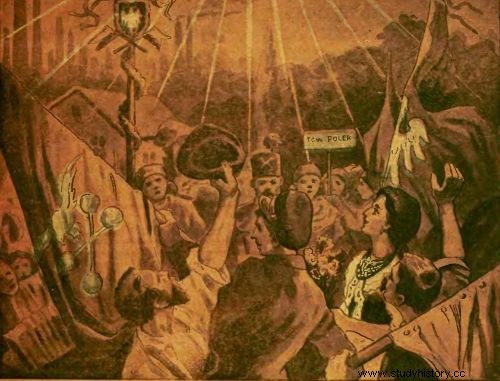
Celebration of May 3 on the cover of the Upper Silesian magazine "Kocynder" from 1921.
In the first years, it was difficult to find a good atmosphere. The holiday was officially established on April 28, 1919, but it was overshadowed by the battles for the border. "Ilustrowany Kuryer Codzienny" of May 5 informed about the "great demonstration of the capital city of Warsaw" organized two days earlier, but also about - "the incredible provocation of the Germans".
While representatives of the state authorities watched the military revue, which proved "the high degree of Polish defense readiness", the German artillery bombed the Polish border town of Wieruszów. Journalists reported that 14 civilians were killed and 60 were injured.
“After a fire of half an hour, a German envoy appeared in the car, who said that it was a punishment (!) For alleging that someone from Wieruszów had stolen a horse abroad. The Messenger demanded, under threat of further bombing, 12 horses in exchange for the stolen or 60,000 marks of ransom ”- we read in the journal.
Waking up at the crack of dawn
Similar, dramatic reports took the entire front two pages of the newspaper. It was only on the third that the Krakow celebrations in which the reporters of "Kuryer" had the opportunity to take part were described in more detail.
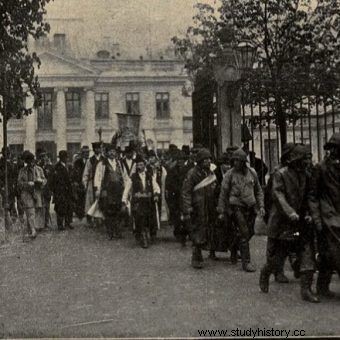
Ceremonial delegations on the way from Belweder to Pola Mokotowskie. Celebrations on May 3, 1925 (photo:"Nowości Ilustrowane").
Cannonballs to cheer at dawn, "national-colored flags" hung in the windows, planting "the tree of freedom". Plus services, services and more services , From seven in the morning until late evening. The celebrations were of a highly religious nature.
The army took care of their proper setting. "Decorated" troops marched through the downtown; special attractions were also prepared. "A military plane was circling above the crowd of thousands who prayed to God" - enthusiastic journalists emphasized.
In the following years, celebrations across the country became more and more solemn. It was not only about showing patriotism, but most of all - about demonstrating superpower ambitions.
"Ilustrowane" reported in 1925 that 14,000 soldiers participated in the parade under the slogan "Nation Under Arms". It was received by President Stanisław Wojciechowski, who officially ordered citizens to make it a "celebration of joy and wedding". In the evening, there was also a banquet for all the cream of the capital's society - one thousand five hundred of the most affluent and influential Poles played behind the closed doors of the Royal Castle.
In Krakow, for a change, it was pouring rain all day long. As a result, "the May 3rd celebrations were limited to church services only".
Circus, flamethrowers and floating tanks
The momentum reached its zenith after the death of Józef Piłsudski, when the specter of an armed confrontation with the Third Reich or the Soviet Union became more and more real. In 1934, "Głos Poranny" admittedly stated that the celebrations turned out to be so grand and popular that "9 people fainted as a result of sunburn and weakness". In turn, in 1938 the daily "Orędownik" reported:
On May 3rd, in Warsaw, in Pole Mokotowskie, great military shows (...). [spectators overdue] stands, standing places and tops of nearby trees. The demonstration of the infantry attack, using dangerous flamethrowers, made a great impression (...).
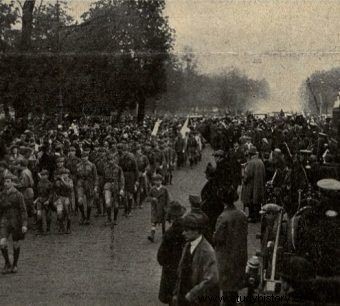
A military parade in 1925 (photo:"Nowości Ilustrowane").
The cavalry and riflemen were showing off their dressage prowess. These performances caused admiration, because they stood on the verge of breakneck circus performances. In the picture in the middle, we see a brave cavalryman making impressive grinders.
The tank demonstrations in action were also very interesting. The illustration on the right shows the tank "walking" through a deep pit filled to the brim with water. As they calculate, these demonstrations, which prove the efficiency of our army, were watched by over 60,000 people.
The journalists of the newspaper did not hide their enthusiasm. In another issue of the same magazine, you can read:“We draw our deepest values, native values, and Polish values from the tradition of May 3. That is why both the red one - from the East and the brown one - from the West - the »holiday« on May 1 will always be a foreign holiday for us and a manifestation of hostile forces to Poland. "

The parade of 1938 in the photos of "The Advocate".
The "Advocate" published it all despite presenting itself as "The Illustrated National and Catholic Daily." And at the same time - he represented, among others, circles whose representatives dreamed of spilling blood on May 3, rather than clapping to the beat imposed by the Sanacja authorities.
Lousy anniversary or lousy celebration?
There were many opponents of the May 3rd holiday. A journalist of the weekly independent body PRAWDA published in Łódź explained in May 1926 that it was an archaic anniversary and not meeting current needs . He suggested that one should celebrate a rather fresh success - the adoption of the March constitution in 1921. He admitted that it was a document full of errors, gross errors and distortions. But that was what made him a success as far as possible in Poland. And not a symbol detached from reality of a long past.
Another problem related to national celebrations was noticed in 1929 by "Głos Poranny". “ Our May 3rd holidays present a very sad picture. Every year they do not deviate from the usual pattern and make the impression of a pre-war gala rather than the National Day in a free, democratic Republic of Poland with a republican system "- explained.
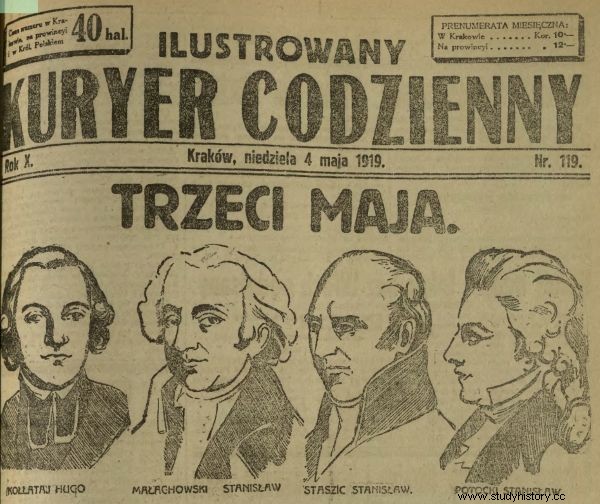
The first anniversary of May 3 in free Poland on the cover of "Ilustrowany Kuryer Codzienny".
The editors pointed out that the parades are deadly boring and monotonous and "everything is organized in such a way as to suppress any manifestations of joy among the gathered audience." Real attractions were reserved for elite representatives. For the chosen ones, separating themselves "from the commoners with a brick wall ... or from the police."
Christmas spanking after the murder
The protective cordons, however, did not really surprise anyone. Even the joyful and carefree May 3rd holiday was often a background for brutal incidents. When in 1934 in Łódź, the National Democratic circles were denied the right to organize their own march, nationalist militias started organizing street brawls.
According to "Głos Poranny", "members of the national party" harassed passersby with Semitic features and smashed windows in Jewish tenement houses. Bands of teenagers even broke into houses, beating random people and demolishing premises.
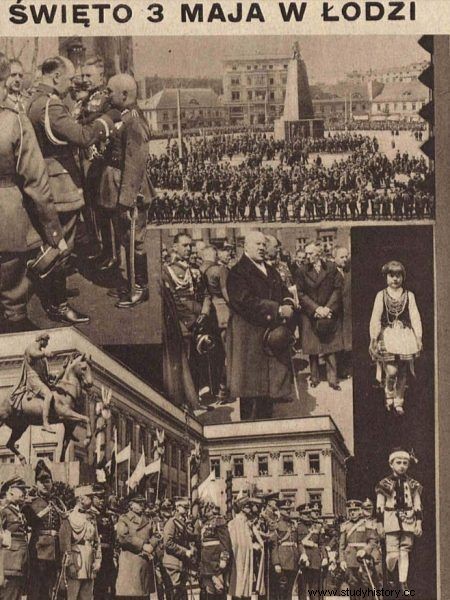
(Photo:Panorama, 1931). Click to enlarge.
There were also excesses with the participation of National Democrats during the mass in the Łódź cathedral. Just as the parish priest, accompanied by the bishop, began to deliver the homily, an "impunity hooligan" burst into the temple, uttering "provocative shouts" and shouting "tavern insults."
A group of nationalists was arrested and put on trial. They were most loudly defended by the already mentioned daily "The Advocate".
Brick and police walls
The incidents in small towns turned out to be even more fierce. "On May 3, at 2:30 PM in Łask at Kilińskiego Street a fight broke out between a group of Jews and a group of Christians as a result of which one of the participants (...) was severely mauled. As a result, a larger crowd gathered and moved towards the houses where the perpetrators were hiding. Despite the immediate intervention of the police, the pressing crowd managed to smash the windows of the above-mentioned houses with stones, ”reported“ Głos Poranny ”.
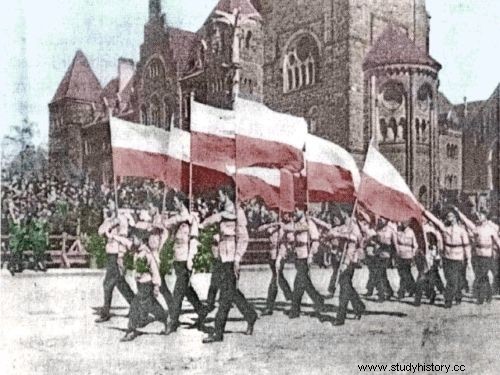
March of Young Nationalists (photo:public domain).
Similar excesses took place each subsequent year, throughout the country. For example, in Tomaszów, in 1938, a whole group of nationalists was arrested, attacking "citizens walking peacefully along the street". And that was just the tip of the iceberg.
In 1937, there were high-profile protests in Lodz, when a Jewish factory owner dismissed one of his workers "for marching in the ranks of the National Party on May 3." A year earlier, the "Illustrated Republic" announced that among the NGOs there were plans to organize a new "national revolution" on May 3 ... There were hundreds of similar stories. Cheers Third May?
